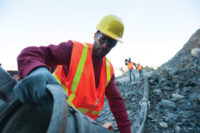One way to safeguard against these serious and costly mishaps? Proper flooring - wisely chosen and rightly cared for.
Good housekeeping
Agency standards for walking and working surfaces apply to all permanent places of employment, except where only domestic, mining or agricultural work is performed. OSHA says some of the most frequently overlooked general requirements involve housekeeping. According to the agency's general industry standard at 1910.22:
OSHA also says it is "unlawful to place, or cause, or permit to be placed, on any floor or roof of a building or other structure, a load greater than that for which such floor or roof is approved."
Slips occur where there is too little friction or traction between the footwear and the walking surface. Common causes of slips include wet or oily surfaces; spills; weather hazards; loose, unanchored rugs or mats; and flooring or other walking surfaces that do not have the same degree of traction in all areas.
Slips, trips and falls can be reduced by good housekeeping, by selection of proper footwear and by improving the appropriateness and quality of workplace flooring. Recoating or replacing floors and installing mats, pressure-sensitive abrasive strips, or abrasive-filled paint-on coating and decking can help lower the risk. Resilient, nonslippery flooring also prevents or reduces foot fatigue and contributes to slip prevention.
Carpet an option
As noted above, there are a great many options for improving flooring safety. One excellent choice is carpeting, says Lisa Dunbar, technical specialist for DuPont Antron, a maker of nylon carpets. Dunbar says her company's product is made from a "four-part system of superior polymer nylon." It's engineered with features that help release dirt more easily than other fibers do, and it also breaks up light in a way that makes soil less visible."We usually recommend carpet over resilient flooring (such as sheet vinyl or vinyl tile) because if there is a spill, it's going to create far less of a hazard than it would on hard surfaces." She says the Antron carpeting is commonly used in a variety of industries, including healthcare, education, service and even manufacturing. She cites the example of an elder-care facility where a wet spot due to a missed spill can be extremely hazardous for workers and patients.
Carpet, especially when it has an attached cushion, has also been shown to be easier on the knee and ankle joints for those who stand for long periods. And if the carpet is kept dry, the chances of microbial growth are low, Dunbar adds.
Invisible solution
A different approach is recommended by Judy Dibble, co-owner with her husband, Earl, of Safe Stride of the Ozarks, Inc. The Missouri-based company treats hard mineral surfaces like quarry tile, ceramic tile and concrete to render them nonslippery. It's an invisible treatment that's guaranteed for two to five years, but has lasted far longer in many instances, according to Dibble.The Dibbles purchased the formula for their product, known as Safe Stride, from a chemist. They became interested in safe flooring after Judy Dibble broke her tailbone when she slipped on the floor of a restaurant where she was employed. The Dibbles' business initially served the restaurant industry, but today applies its product to floors in a variety of industries and businesses, including meatpacking plants, manufacturing facilities, airports and zoos.
Dibble says most architects specify floors based on durability and appearance. Her company is called in after the fact, once the user has determined that employees or customers are slipping. One recent Safe Stride job was for a manufacturer whose forklift trucks had to travel down a long, sloping tunnel. The trucks were having trouble stopping and more than once had crashed through a wall!
The fundamentals
Whatever your choice of flooring, make sure you:
- Train your employees to move carefully and wear proper footwear;
- Keep walking and working areas well lit;
- Make sure spills are cleaned up promptly;
- Secure mats, rugs and carpets that do not lie flat;
- Maintain good housekeeping habits.
SIDEBAR: What you can do to prevent slips, trips & falls
When we think of falls, we often think of ladders or loading docks. However, often slips and trips are the result of flooring surface, causing not only bumps and bruises, but a risk of broken bones, torn ligaments and sprains, as well.To prevent incidents involving flooring, every individual should follow these simple rules of thumb:
- Watch where you are going.
- Wipe your feet on entrance mats when it is raining, snowy, icy or muddy outside.
- Walk carefully on wet or waxed floors.
- Pay attention when flooring is uneven, changes level or changes surface (for example, from flooring to carpeting).
- Clean up or report all spills.
- Be aware of where spills are most likely to occur: Hallways leading to outside doors; maintenance areas; restrooms; lunchrooms; lounges and waiting rooms; facilities where water is in use.
- Prevent spills by covering all liquids, even water or coffee. If a container, such as a pail, can't be covered, don't fill it to the top.
- Warn your co-workers by posting signs and giving verbal warnings about spills or other flooring problems.
- Report loose or missing tiles, warped or cracked flooring, and turned-up rugs.



